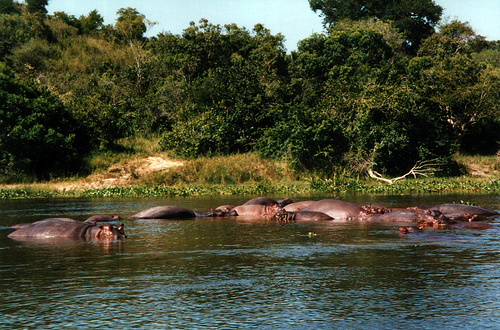經管紐約市動物園、水族館和全球2億英畝陸上保護區的國際野生生物保護學會(Wildlife Conservation Society),5日在《自然》期刊發表新研究:「保護區績效和潛能」,指出由於缺乏資金和政治承諾,全球保護區未能完全發揮保護境內瀕危動植物的作用。
刪減預算 保護區功能無力彰顯
國際野生生物保護學會、澳洲昆士蘭大學和世界自然保育聯盟(IUCN)保護區委員會的專家聯合警告,不論是在開發中或是已開發國家,各國政府因刪減相關預算和修改政策,已與保育的初衷漸行漸遠。
根據研究,每年分配450至760億美元──僅全球軍事支出的2.5%──給保護區,就能幫助有效管理,確保保護區完全發揮功能。
一份近期的全球性分析記錄到543個保護區狀態退步,甚至遭到解除的案例。例如:
- 加拿大公園近日刪減預算,保育支出減少了15%。
- 在烏干達,許多保護區內都在進行石油探勘和開發活動,包括默奇森瀑布國家公園。
- 2010年時,印尼在481,000公頃的保護區內核發採礦許可證。
- 在俄羅斯的科米原始森林,Yugyd Va國家公園等保護區邊界因採礦而遭到改變。
- 阿曼政府縮減90%的阿拉伯羚羊保護區面積,以利鑽油和開採天然氣,導致被世界遺產除名。
「現在最重要的工作,是讓各國瞭解保護區的投資報酬,體認到保護區對地球生物的未來有多重要。我們希望在近期12-19日召開的IUCN世界保護區大會上達成這個目標。」IUCN總幹事Julia Marton-Lefèvre說。
缺乏管理 保護區只1/4有效
亞洲象、虎和所有犀牛物種等瀕危動物以及多種植物、爬蟲和兩棲類因為保護區的存在得以延續。研究作者指出,管理得當的海洋保護區,大型魚類的生物質量是開放漁場的5倍,鯊魚生物質量是14倍。
目前保護區占陸地的15%和海洋的3%。專家警告,儘管過去一世紀內保護區覆蓋率有所增加,距離2020年全球目標17%陸地和10%海洋,還有待努力。
氣候變遷和盜獵威脅與日俱增,讓全球保護區處境雪上加霜。許多生態系統仍未被有效的保育,因為有些重要的生物多樣性地區還不在保護區範圍內。此外,目前大部分位置適當的保護區並未有效利用資源,有研究顯示只有4分之1被有效管理。
「許多知名保護區,包括厄瓜多加拉巴戈國家公園,正在嚴重劣化,部分原因是未能有效管理。不過確保保護區完全發揮效果的責任並非只在政府。我們必須尋找創新的募資和管理方法,讓政府、企業和社群團體都能積極參與。」研究共同作者、昆士蘭大學教授兼IUCN保護區委員會委員Marc Hockings教授說。
The Wildlife Conservation Society, which manages New York City’s zoos and aquarium plus 200 million acres of protected lands around the world, today sounded the alarm that the world’s protected areas are not fully protecting the imperiled animals and plants within their borders due to lack of funding and political commitment.
In a new study, “The performance and potential of protected areas,” published today in the journal “Nature,” experts from the Wildlife Conservation Society, the University of Queensland, and the IUCN World Commission on Protected Areas warn that governments in both developing and developed countries are backtracking on their commitments through funding cuts and changes in policy.
A recent global analysis has documented 543 instances where protected areas had their status downgraded or removed altogether. For example:
* – Recent cuts to the Parks Canada budget have reduced conservation spending by 15 percent.
* – In Uganda, active oil exploration and development is occurring inside many protected areas, including Murchison Falls National Park.
* – In Indonesia, in 2010, mining permits were issued inside 481,000 hectares of protected areas.
* – In the Virgin Komi Forests in Russia, significant boundary changes have been made to reserves such as the Yugyd Va National Park to allow mining.
* – The Arabian Oryx Sanctuary in Oman was removed from the World Heritage List after the government reduced the size of the reserve by 90 percent to allow for oil and gas extraction.
“The key now is for countries to recognize the return on investment that protected areas offer and realize that those places are fundamental to the future of life on Earth. This is exactly what we hope to achieve at the upcoming IUCN World Parks Congress,” says Julia Marton-Lefèvre, IUCN Director General.
According to the authors, allocating US$45 to $76 billion to protected areas annually – just 2.5 percent of the global annual military expenditure – could help adequately manage those areas, ensuring their potential contribution to the well-being of the planet is fully met.
Many threatened species, such as the Asian elephant, the tiger, and all rhinoceros species, as well as numerous plants, reptiles and amphibians, survive due to protected areas.
Well-managed marine protected areas contain more than five times the total large fish biomass and 14 times the shark biomass compared with fished areas, the authors point out.
Protected areas cover around 15 percent of land and three percent of oceans. Experts warn, however, that despite the increase in their coverage over the past century, this is still short of the global 2020 targets to protect at least 17 percent of land and 10 percent of oceans.
Many ecosystems remain poorly conserved because protected areas do not always encompass the most important areas for biodiversity.
In addition, the vast majority of existing protected areas that are well placed do not have sufficient resources to be effective, with some studies finding as few as one quarter of them are being effectively managed.
Growing threats from climate change and the escalating poaching crisis place additional pressures on protected areas globally, the authors warn.
“Some of the most iconic protected areas, such as Ecuador’s Galapagos National Park, are undergoing significant degradation, partly due to an inability to manage them effectively,” says Professor Marc Hockings of The University of Queensland,co-author of the study and member of the IUCN WCPA.
“But governments cannot be solely responsible for ensuring that protected areas fulfill their potential,” he said. “We need to find new, innovative ways to fund and manage them, actively involving government, business and community groups.”
※ 全文及圖片詳見:ENS







